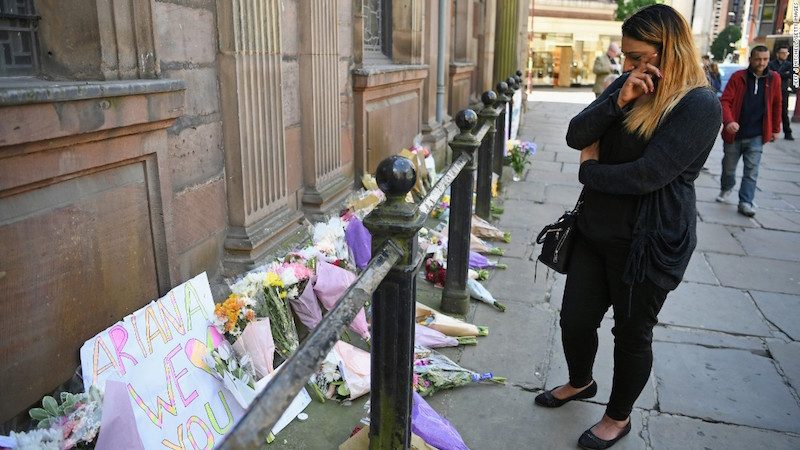The plan was always and only to kill as many girls as possible.
A concert on a Monday night–a school night. But young girls and their parents and other fans were not about to miss the massive concert of American pop star Ariana Grande.
Despite the unlikely name of the 23-year-old former Nickelodeon star’s world tour–Dangerous Woman–Grande is known for her family-friendly shows and songs.
The concert-goers at the Manchester Arena, one of the largest venues in U.K., had had a fantastic time. When Grande ended her concert at 10:30pm GMT on May 22, the applause had been wild.
Salman Abedi, a 22-year-old Briton of Libyan descent, had detonated a homemade bomb filled with ball bearings and nails which act as shrapnel, outside the arena. It was 10:35pm.
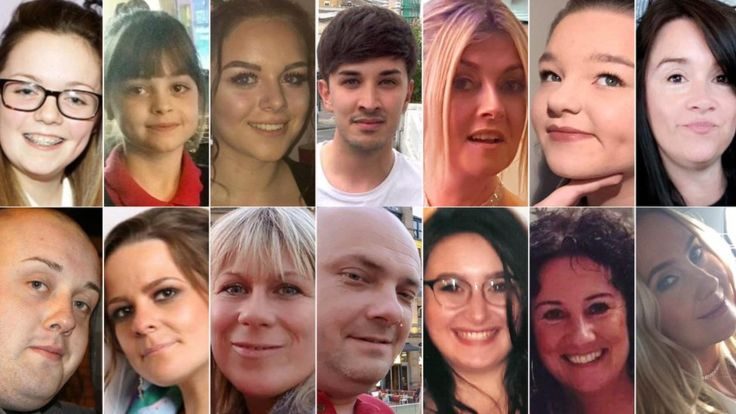
IDENTIFIED VICTIMS OF THE ATTACK SO FAR – CLOCKWISE, FROM TOP LEFT: GEORGINA CALLANDER, SAFFIE ROUSSOS, OLIVIA
CAMPBELL, MARTYN HETT, MICHELLE KISS, SORRELL LECZKOWSKI, ALISON HOWE, LISA LEES, JANE TWEDDLE-TAYLOR, NELL
JONES, MARCIN KLIS, ANGELIKA KLIS, KELLY BREWSTER AND JOHN ATKINSON
After that, it was blood, mayhem, screaming–endless screaming. Parents who had come to collect their kids waited frantically outside the arena as ambulances began to arrive. Would their child be among the missing, or worse, the injured or dead?
A few hours later–hours in which Manchester natives opened their doors to total strangers and the local hotels turned their lobbies into safe spaces for concert-goers unable to get home–all was quiet. There was rubble, there was yellow police tape and there were flowers, notes, candles, small stuffed animals. Grande’s ubiquitous pink balloons.
The singer herself was physically unharmed but her tweet evoked her devastation.
broken.
from the bottom of my heart, i am so so sorry. i don’t have words.— Ariana Grande (@ArianaGrande) May 23, 2017
Of the victims identified thus far, the oldest was 51-year-old Jane Tweddle-Taylor, married mother of three, waiting to pick up a friend’s daughter. The youngest was attending her very first concert, eight-year-old Saffie Rose Roussos.
There was 15-year-old Olivia Campbell, whose frantic mother, Charlotte, had been giving tearful televised pleas for hours as she hoped against hope that her daughter had just not been able to contact her. There was the “inseparable” teen couple, Chloe Rutherford, 17, and Liam Curry, 19, now inseparable forever.
There were several parents, other teens, two young men in their 20s, John Atkinson and Martyn Hett–the latter loved to dress in drag as his favorite soap star.
Parents of some of the dead are remain in hospital, gravely injured, some not knowing their children are dead. More than a dozen very young children are among the 64 being treated for serious to critical injuries.
The aftermath of the bombing was, young witnesses detailed, a bloodbath.
Prime Minister Theresa May, two weeks away from an election, gave a fierce speech outside 10 Downing Street of the sort we have all become far too familiar with in recent years. Her voice caught, but she soldiered on. It was the second time she’d done this in her very short tenure as Prime Minister. There was a note of weariness to her voice that was not ascribed to the early hour but to the knowledge she would be doing this again. And again.
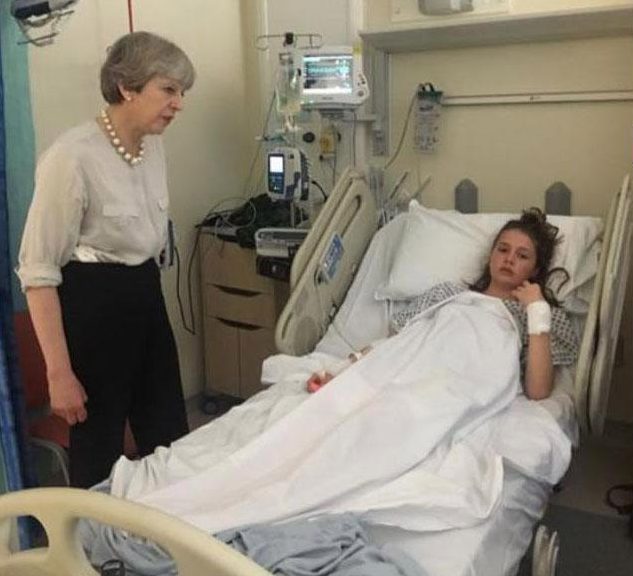
Evie, 14, was pictured with Theresa May as she recovered in hospital.

World leaders sent their own regards and prayers for the victims: Angela Merkel, President Trump, former President Obama, former Secretary of State Hillary Clinton.
Outraged & angry about this cowardly terror attack on a crowd of young people. Sending sympathy & strength to victims & people of Manchester
— Hillary Clinton (@HillaryClinton) May 23, 2017
Our hearts go out to those killed and wounded in Manchester. Americans will always stand shoulder to shoulder with the people of the UK.
— Barack Obama (@BarackObama) May 23, 2017
We stand in absolute solidarity with the people of the United Kingdom. pic.twitter.com/X6fUUxxYXE
— Donald J. Trump (@realDonaldTrump) May 23, 2017
The Union Jack sprang up over Twitter and pundits intoned “We are all Manchester” or “We are all British.”
We believe there is some protection in the talisman of solidarity. We are still not wholly sure terrorism is something the West must come to terms with. It still–9/11, 7/7, the Madrid and Paris attacks all notwithstanding–seems foreign to us.
In the 48 hours since the bombing, other members of Abedi’s family have been arrested. ISIS has claimed responsibility. Vigils have been held.
Soon the funerals – all of which Ariana Grande has offered to pay for – will be held.
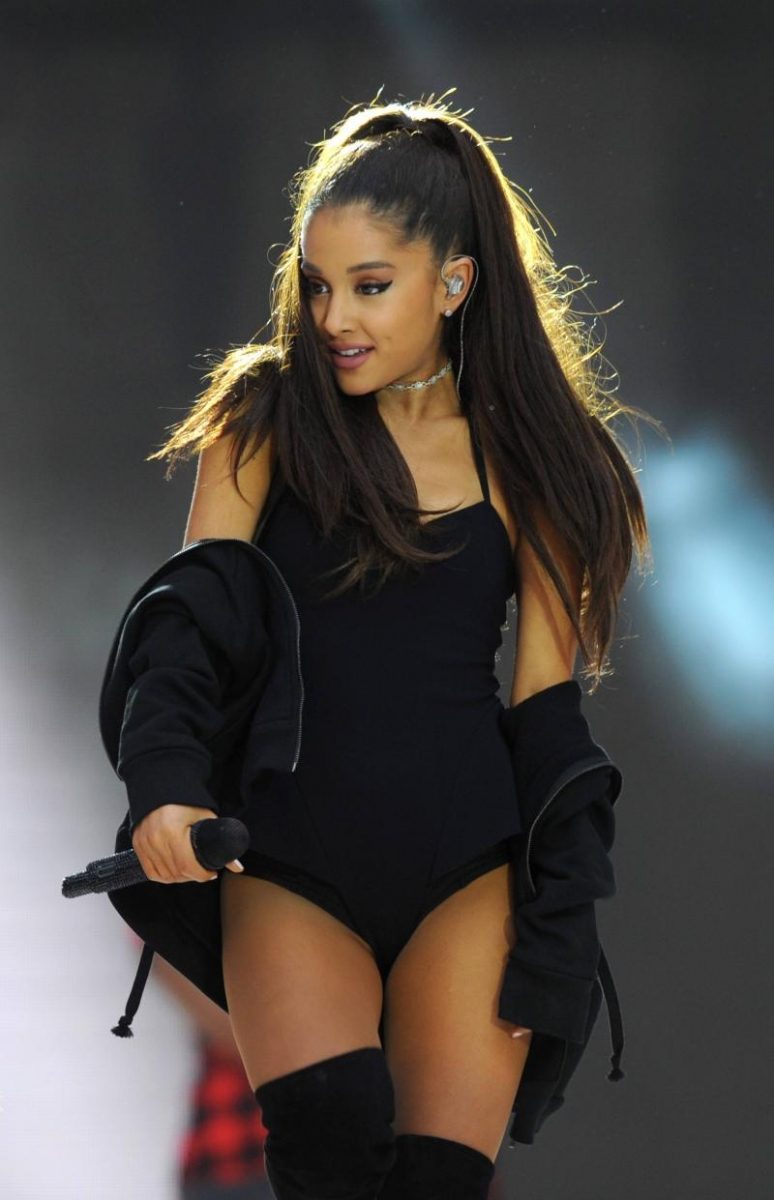
Ariana grande has offered to pay for all funerals of those who lost their lives.
And then we shall move on. As a young schoolboy mate of one of the victims said in a BBC newscast the morning after the bombing, “We have to move on. Get back to normal. Or else they win, don’t they?”
It was the second terrorist attack in the U.K. in as many months. On March 22, Khalid Masood drove a car into pedestrians, killing four, injuring 50. He then stabbed a police officer, PC Keith Palmer, to death. Masood was shot dead at the scene.
These are just two of the terrorist attacks that have shaken the world. The names of cities blur. We shut out the names of the murderers. There were literally thousands killed in terrorist incidents in 2016 – so many, I had forgotten them all.

Kelly Brewster – Victim of the bombing
We ignore the ones in the Middle East. We have come to believe that when people are blown up waiting for a bus or going to a market or walking down a crowded street, it is part of daily life in that part of the world. The way random gun violence and mass shootings are in America. We aren’t any more shocked about that than we are when there’s 30 shootings over a weekend in Philadelphia or Chicago or Los Angeles.
That’s how inured we are.
But when a suicide bomber walks into a concert hall or a railway station–that is terrorism as we have come to know it. When a man rams a truck onto an esplanade and mows down everyone in his path, that is terrorism.
We are, as Westerners, more likely to remember the attacks on cities and countries with which we have fealty. In April alone there were attacks in Paris, Sweden, St. Petersburg. But in the past year there were so many other attacks–Paris, Brussels, Nice, Berlin, Hamburg, Normandy, Istanbul. Hundreds of dead. A few thousand injured.
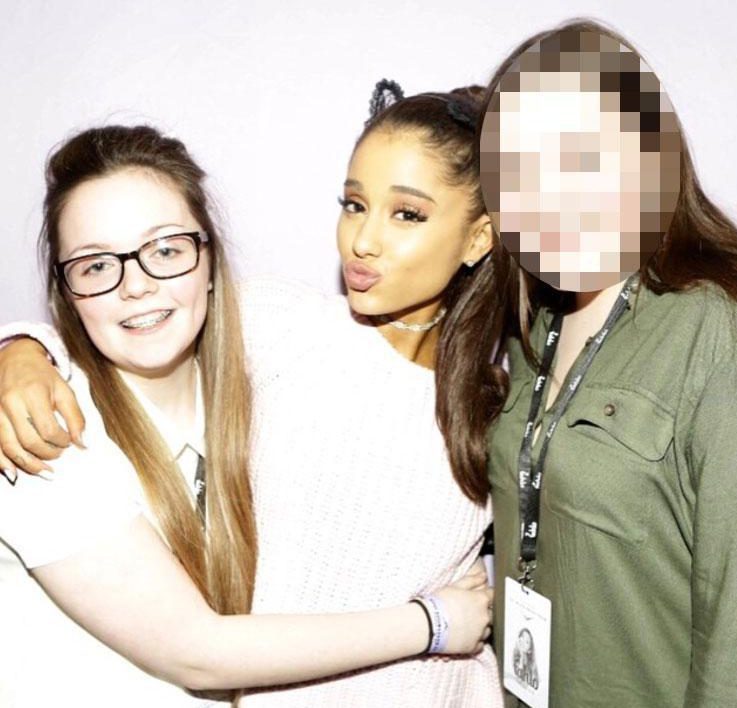
Georgina callander – victim of the bombing – pictured with her hero ariana grande
Only a week before the bombing in Manchester, a Bronx man, Richard Rojas, drove his car into a crowd in Times Square, killing one woman and injuring 22 others. He told police, “I wanted to kill them all” and said “God told me to do it.”
He has been charged with murder and a slew of other charges. He also said he was “very, very angry.”
Media spend a lot of time detailing the events of terrorist attacks like the Manchester bombing. Experts explain about “radicalization”–but where was Rojas radicalized? Where was Adam Lanza, who shot up a classroom full of first graders two weeks before Christmas in the quiet Connecticut suburb of Newtown radicalized? Where was Elliot Rodger, who went on a rampage to kill young women who wouldn’t have sex with him, radicalized? The three year anniversary of that massacre was May 23.
The laser focus will be on terror cells in Manchester’s Libyan community until the next attack somewhere else. Or the next mass shooting in America. We will continue to ignore the other killings because the number of dead is small – one, two, maybe three.
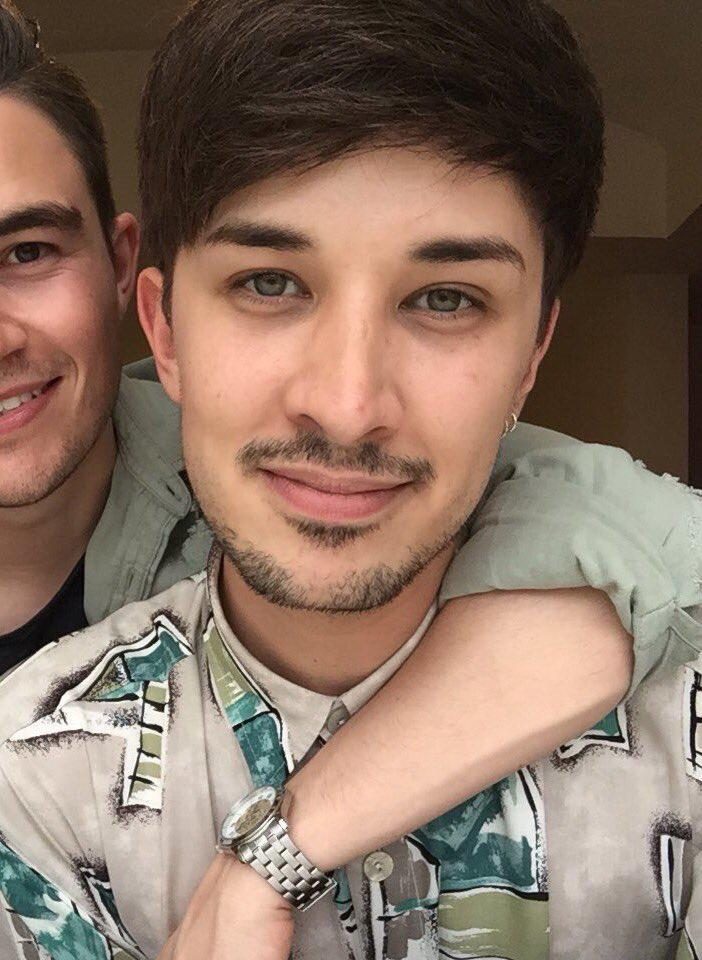
Martyn hett, 29, confirmed victim of the terror attack in Manchester
Yet the source of the violence is the same. Islam? Mental illness? Drugs?
None of the above. The source of the violence is men. I know – we aren’t allowed to say it. But it’s the reality. Terrorism in all its forms–bombings, shootings, mass vehicular homicide–is the purview of men.
We insert the hashtag #NotAllMen in tweets to protect ourselves from the onslaught of (almost always young white) men telling us we are “misandrists” for suggesting that men have cornered the market on mass violence.
But what protects us from the violence itself?
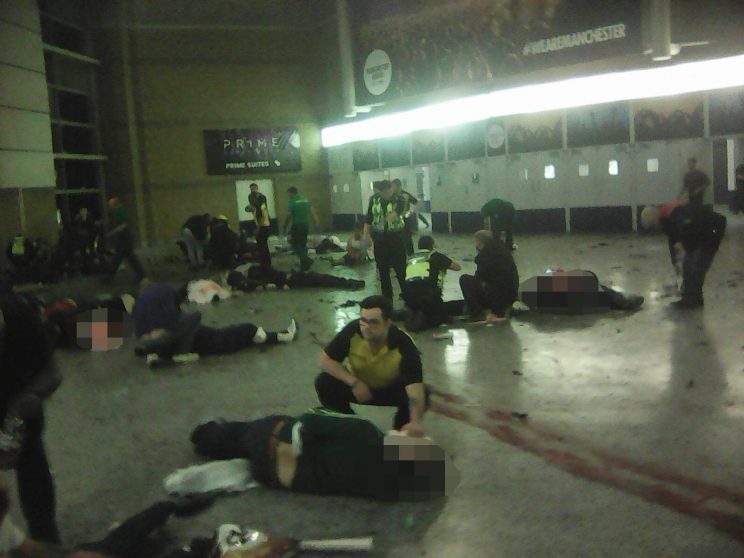
the aftermath of the terror attack in Manchester
The Manchester bombing took careful planning. There was a second explosive detonated by police after the initial carnage. Make no mistake, the victims were not random. The killers–Abedi did not work alone–wanted to kill as many young girls and women as possible. And he, they succeeded–with only a few exceptions, the dead and injured were girls and women.
Young girls wearing #ArianaGrande‘s characteristic kitty kat ears were the targets tonight of a terrorist with an IED.
Unconscionable. pic.twitter.com/8RZapHEjfB
— Victoria Brownworth (@VABVOX) May 23, 2017
Even as I write this, CNN is telling me the latest. Security analysts are discussing the breadth of the terror cell. Talk of ISIS and how to stop terrorism–discourse I have been hearing and reporting on for years, now–continues.
Never once have I heard the actual source of the problem discussed.
Yet nearly every day Americans see it in our own president. He can’t control himself from his need to deliver angry tweets against his perceived “enemies,” who have ranged from his opposition, Hillary Clinton, to former President Obama, to the media, to a former Miss Universe, to a former FBI director, to a Gold Star family. His tweets are often outrageous falsehoods, like when he accused Obama of wiretapping him and declared Obama was a “sick, bad guy.”
Trump’s weapon is Twitter. What if it were an AK47 or a homemade nail bomb or he got more impatient than usual and triggered a nuclear attack? Rojas declared he was very very angry so he got in his car and tried to kill a few dozen people in broad daylight in Times Square.
We should–we must–address this factor of male violence and toxic masculinity that demands control over the bodies of women in a myriad of legal, religious, social and physical ways and which demands control over the lives of those who are perceived to be weaker than the perpetrators.
#NotAllMen, of course. We have to say that. We have to qualify it.
Not. All. Men. A hashtag. A subordinate clause. A politically correct qualifier.
But the stark reality is that it’s men building the bombs, buying the assault rifles, getting the killing cells together to take out “soft targets” like eight-year-old Saffie Roussos and 15 year-old Olivia Campbell and that love-struck teen couple Chloe and Liam.
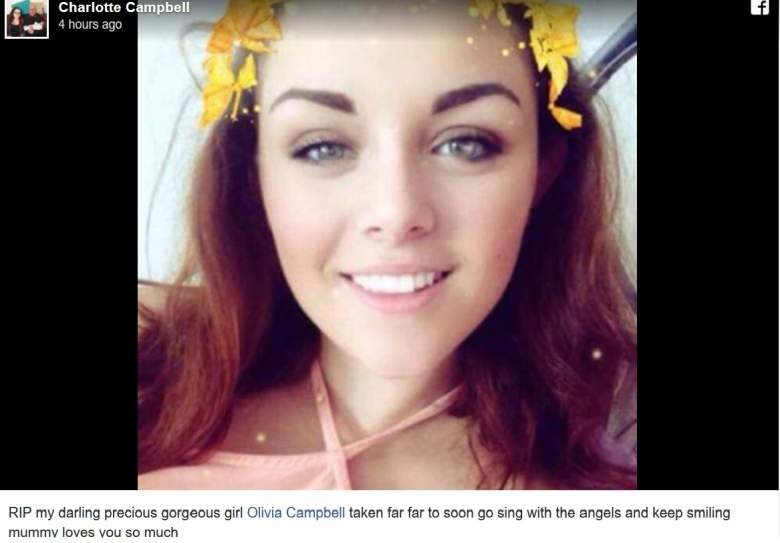
olivia campbell – confirm victim of the terror attack in manchester
We have task force upon task force about homeland security and terrorism, but how many women are on those and if there are any, who among them would be brave enough to raise her hand as ask, “Weren’t all these guys radicalized at puberty when the testosterone flooded their systems and their limbic system was not yet developed and their impulse control was stunted?”
If anyone were honest, the answer would be yes.
But we don’t live in a world that addresses toxic masculinity or there wouldn’t be so much of it. Toxic masculinity is entitlement like that we witness every day in our president–while our former president is the very epitome of why we must indeed say #NotAllMen, with his calm demeanor and slowness to any show of anger. Toxic masculinity is bolstered by the the idea that strength–and violence–are answers.
Trump repeatedly referred to Obama as weak prior to running for president. Throughout the election Trump referred to his opponent, Hillary Clinton, as “weak, low-energy, no stamina.” Trump has always used fear as his weapon–telling his supporters that Mexicans were rapists and Muslims were terrorists and black Americans were prone to gun violence.
Terrorists believe they have the right to use weapons–bombs, guns, vehicles–to take out “soft” targets. And what could be softer than an arena filled with mostly tween and teen girls and their mothers? Toxic masculinity is built into religious and political zealotry which assert that men must control women and girls and gays or face shame of being themselves “soft.”
A year ago Omar Mateen went to the Pulse nightclub in Orlando and murdered 49 LGBT people and wounded 53 others. He was rumored to be bisexual. Like many terrorists, he had practiced his violence on the women in his life: he had abused both his wives.
The numbers are staggeringly clear–study after study, backed by law enforcement statistics show us the terrorists and mass shooters are 98% men.
When are we going to address this reality? The pandemic of rape, the fact that one in three women in the world–that’s more than a billion women–will be a victim of male violence, according to the World Health Organization? The pandemic of domestic violence? The increasing number of terrorist attacks and attacks like Rojas’ not deemed terrorist simply because, it seems, the perpetrator is not Muslim.
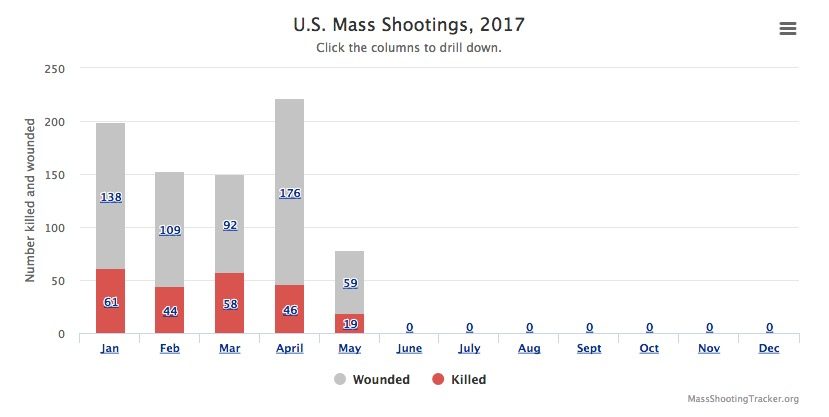
Men’s rights advocates are quick to point out that men are more often the victims of violence than women, men are themselves “soft targets” and they are. But the perpetrators are also, again, men.
Society pressures men to disconnect from empathy, to “man up,” to not be “a pussy”–the worst thing you can call a man is a slang term for female genitalia. That tells you everything about where we situate masculinity and how readily boys are trained to take it toxic.
And so we mourn Manchester. The tragic victims whose names will be added to the victims who have already blurred in our collective memories, if not the memories of those for whom their lost will always be a throbbing wound.
IMAGE: Dubai’s Burj Khalifa, the world’s tallest building, after Manchester bombing. pic.twitter.com/qVCfb15IYp
— The Spectator Index (@spectatorindex) May 24, 2017
The push back on this will be strong, but until and unless we address this most fundamental factor of terrorism and mass male violence, we won’t be able to stop it. Until we keep young men from isolating away from empathic influences, until we break down some of the tribalism that men of all races, religions, societies engage it, be it the gang rapes by football players or terrorist attacks on girls at a concert, we are not going to get closer to a safer, less terroristic society.
Male violence is promoted and applauded in films, TV, video games. The winner is the one who kills the most, not the one who’s the “pussy.” Until it becomes safe for men to be soft, the rest of us will be at risk–every day, everywhere, from our own homes to the most benign of venues.
That is the lesson of Manchester that we should all learn. Before we have to learn it yet again.
